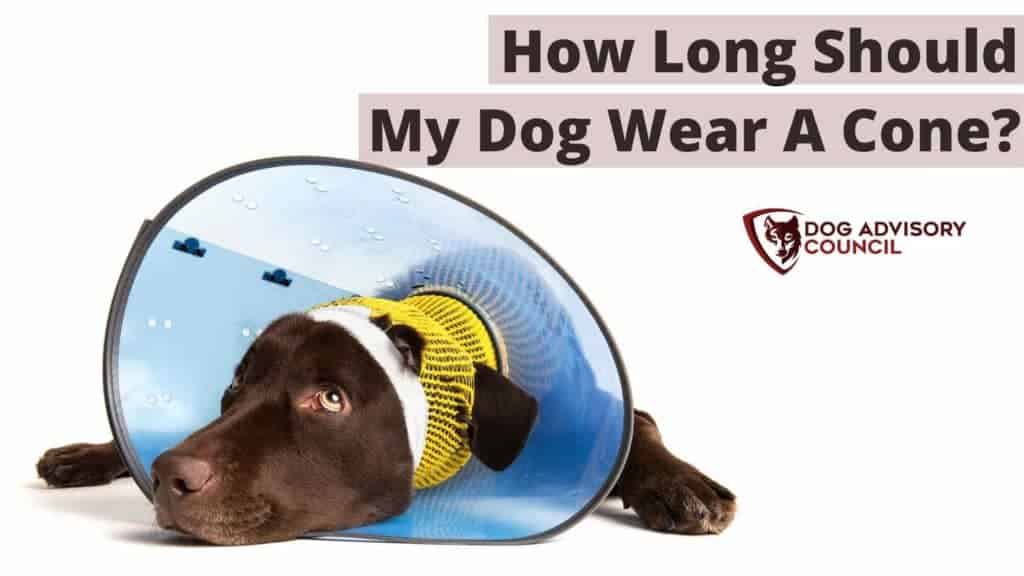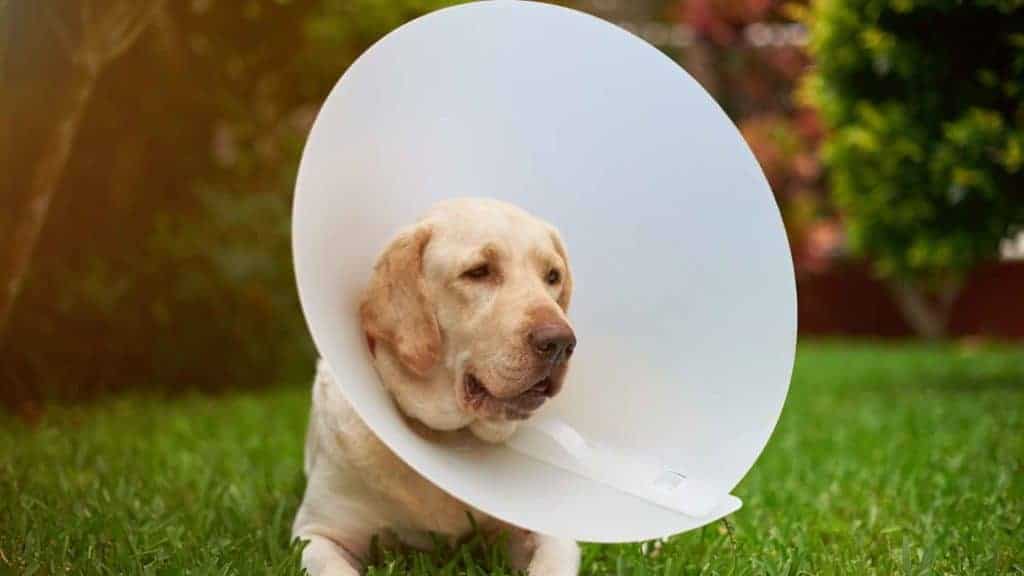
Is your dog now a member of the “cone of shame” club? If so, you might be curious just how long you need to put up with their lampshade effect (and dirty looks). Below is all of the information you need!
In most cases, dogs will need to wear their cone for about 7-10 days. This timeline gives the injury or incision time to heal appropriately without interference by your dog’s sniffing or licking.
The cone (also known as Elizabethan Collar) should be worn at all times unless otherwise directed by your vet.
Reasons dogs need to wear cones
There are several causes for dogs requiring ones. No matter what the actual cause is, the main reason is to allow for recovery time. It acts as a block for your dog to keep them from picking at a healing injury or incision. Some of the leading causes for a cone “prescription” for your dog include:
- Surgery recovery
- A spay procedure
- A neuter procedure
- Recovering from an injury requiring stitches
Surgery recovery
If your dog has some sort of surgery, they will have sutures or staples that will work to keep the incision closed and promote an easier healing process. It could be major or minor. Your dog will need to wear a cone so that they don’t pick at the incision and pull the stitches out. This can infect the wound and lead to a longer recovery time, not to mention other complications.
A spay procedure
A spay is considered a “routine” surgery. This is when a female dog has her reproductive organs removed. Still, it requires a small incision on her belly and is sutured shut. She will need to wear the cone of shape to keep from picking at it, much like above.
A neuter procedure
This is when a male is desexed, though this is equivalent to a human vasectomy. Seen as being a minimally invasive surgery, this one still requires a cone. Many dogs will still like to lick and pick at the “itchy” site, so the cone is just as important as in a more invasive spay surgery.
Recovering from an injury requiring stitches
If they had a wound that needed stitches, or even just a wound treated with antibiotics. In that case, the cone helps ensure there is no infection and that any kind of medicated cream you use isn’t licked off. Not only will it not be able to do its job, but it could also be harmful to your dog since these are intended for external use only!
When can I take off my dog’s cone?
The recovery time will depend on many factors, but the above mention of approximately 10 days is the typical guideline. For best results, though, you’ll want to check with your vet! They’ll tell you signs to watch for or make a personalized recommendation based on the healing process for your dog’s situation.
Can my dog sleep with a cone on?
Yes, dogs can absolutely sleep with a cone on. Will they be happy about you? No, not at all. So the question then becomes: how do dogs sleep with a cone on their head? It’s all about the cone that you choose. The first night, no matter what, will be a little uncomfortable as your dog adjusts.
Now, you can find rigid fabric ones that will help them feel like they’re sleeping on a cushion even as they are still in their one. Stiff plastic cones will be the trickiest for your dog to adjust to. There are also inflatable ones that you can lower slightly before bedtime to offer them an easier time (just don’t deflate them too much).
As far as technique, the main thing is to accommodate your dog’s content if they sleep with you. Make sure they don’t accidentally bash you in the head with it or get it jammed in between the lamp and the bedframe overnight, knocking everything over.
Your dog will adapt to sleeping with a cone on in a single night, in most cases. It will bother us more than it will bother them!
Can dogs wear cones 24/7?
Yes! Cones are perfectly safe to wear 24/7. The most important thing is to check their neck for chafing or other signs that you may need to address the fit of the cone itself.
Can I take my dog’s cone off after 8 days?
If your vet says that 8 days is okay, then you can take the cone off. If the recommendation is longer, though, you’ll want to “stay the course” and keep it on. Again, a vet is the best person to know when the right timing is!
How long should my dog wear the cone after spay?
After her spay surgery, her cone wearing will be a little different. Since this is a bit more invasive surgery, the healing itself will be different, too.
Do dogs get depressed wearing a cone?
While a cone can make your dog cranky, to be sure, they won’t get depressed with the cone on. The cone is frustrating for them because it can change their depth perception, and they are ramming into things or knocking things over, etc. You will have a better chance of your dog having a serious case of the crankies more than depression!
If you are worried about it, though, just associate the cone with good things. Maybe a few extra treats, some ear rubs, pets, etc. Before long, they’ll just be so happy with the amount of love they’re getting; that’s all that’ll be on their mind!

How can a dog drink water with a cone on?
Most dog owners will find their first attempts at eating or drinking pretty funny. They will often upset the bowl, tip it over, or spill it everywhere with their cone. You may need to clear kibble or water out of the inside of the cone, too.
Eventually, your dog will get used to tipping their head down further to get the bowl adequately lined up with its cone. Dogs are pretty adaptable, after all.
How can I keep my dog from licking a wound without a cone?
Realistically speaking, a cone is given to your dog because it’s required. You should keep the cone on as directed by your vet when you bring your dog home.
Some vets will be okay with you removing the cone for a short time to give your dog a break. You can safely do this, but you will need to watch them very, very carefully. You will need to keep them from picking at the incision. As soon as you leave to do something else, even for “just a minute,” put the cone back on!
If your dog struggles to eat or drink with the cone on, you can remove it during those times, too. Just make sure you put it back on right after!
Alternatives to the dog cone
If you just can’t stand the idea of the cone, or you feel that your dog is miserable, there are a few alternatives to the cone that you can consider. These include:
- A t-shirt
- A travel pillow
- An inflatable collar
- A fanned fabric collar
A t-shirt
You can put a t-shirt on your dog if you want to keep them from picking at the wound, but this is often not recommended unless you can watch them carefully. Dogs can easily push the fabric aside and will pick at the site. As well, the fabric can chafe and cause more problems. You can get surgical suits intended to be better designed to cover the site and give your dog the freedom they need to recover.
A travel pillow
While many vets will frown upon it, some do use a travel pillow. The main thing with this is that you will have to get the fit just right. Otherwise, it’ll be too tight and restrict their breathing, or so loose that they will just wiggle out of it.
An inflatable collar
These are especially popular with large dogs. They sit down on the neck like a collar, and you can inflate them so that they will be unable to tilt themselves to get access to the incision or wound. These are widely available and are a great alternative, though they can be tricky at times for those dogs that want to sleep.
A fanned fabric collar
This would be a bit smaller than a cone but fan out wider. It is the best chioce for visibility as far as fitting like a cone, but it can mean that destruction is more likely in your home!
How should a dog cone fit?
Your vet will show you a personalized approach to fitting a dog cone properly, but the general idea is that it should fit like a collar. Tight enough that they have no way to slip out of it but loose enough so that you can squeeze your fingers beneath it.
This will give them the best comfort but won’t allow them to get out of it when your back is turned!
How to make a dog cone more comfortable
Is your dog having a tough time with its cone? You can make it more comfortable by attaching it to their literal collar. This makes it an easy fit that won’t rub or chafe. If the size seems to be an issue, get a size larger or smaller (depending on the issue). Just adjusting the size one way or the other can make it a little easier.
One of the best things you can do is not to make a big deal of it. Just act like your dog is normal, and they’ll find a sense of serenity in the fact that you seem normal, too. Their insecurities can cause more discomfort than the cone itself, after all.
Similarly, you can offer them a break from the cone once a day, but you will need to make sure that they are supervised. If they start to pick at the incision and will not listen to you, then the cone should stay on in the future.
As mentioned above, you can consider an alternative to the cone if your dog is trying to chew it or is acting differently from their usual self. After all, some dogs just aren’t going to adjust to the cone, and that’s okay!
If you want a more personalized approach, you’ll want to ask your vet about how you can adjust it to help your pup.
In general
A dog typically will need to wear their cone between 10-14 days. This gives the incision time to recover and heal without your dog picking at it.
Most dogs will adjust quickly to it so that it is no big deal, though you can consider alternatives to the cone if your dog is unhappy or uncomfortable during its healing process.
While wearing a cone is no one’s idea of a good time, it is crucial to follow the instructions from your vet for your dog’s health.
Do you know someone with a “cone of shame” problem? If so, this could be the lifesaver that you are looking for! Feel free to share it and the relief it’ll offer.
